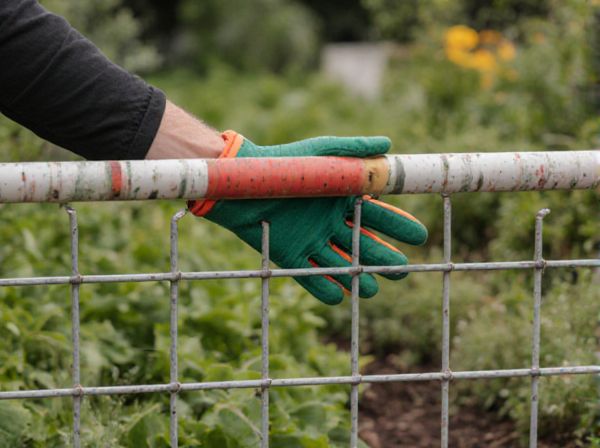
Physical barriers vs Pesticide sprays Illustration
Physical barriers such as nets, row covers, and trenches provide a non-toxic method to prevent pest access while preserving beneficial insects and reducing environmental impact. Pesticide sprays offer quick and effective pest control but can harm non-target species, contribute to resistance development, and affect soil and water quality. Selecting between these methods depends on pest severity, crop type, and sustainability goals for integrated pest management.
Table of Comparison
| Aspect | Physical Barriers | Pesticide Sprays |
|---|---|---|
| Definition | Physical structures blocking pests (nets, screens, traps) | Chemical substances applied to kill or repel pests |
| Effectiveness | Prevents pest entry; long-lasting if maintained properly | Immediate pest reduction; may require repeated applications |
| Environmental Impact | Eco-friendly; minimal ecosystem disruption | Can harm beneficial insects; risk of pollution and resistance |
| Cost | Initial investment higher; low recurring cost | Lower upfront cost; frequent purchase increases total expense |
| Safety | Non-toxic; safe for humans and pets | Potentially toxic; requires handling precautions |
| Application | Installed once; minimal maintenance | Regular spraying needed; labor intensive |
Introduction: Physical Barriers and Pesticide Sprays in Pest Control
Physical barriers such as nets, screens, and row covers provide an eco-friendly solution by preventing pest access to plants, significantly reducing damage without chemical use. Pesticide sprays offer targeted pest elimination, effectively controlling infestations but may impact beneficial insects and contribute to resistance over time. Combining physical barriers with strategic pesticide application enhances integrated pest management efficacy while minimizing environmental risks.
Understanding Physical Barriers: Types and Effectiveness
Physical barriers such as row covers, mesh screens, and sticky traps provide effective pest control by preventing insect entry without chemical exposure. These barriers reduce pest populations by physically blocking access to plants, minimizing damage and contamination risks associated with pesticide sprays. Choosing the right material and installation method enhances durability and pest resistance, ensuring long-term garden protection.
Overview of Pesticide Sprays: Chemical and Organic Options
Pesticide sprays encompass both chemical and organic options designed to manage pest populations effectively. Chemical pesticides often provide rapid, broad-spectrum control but may pose environmental and health risks, while organic alternatives use naturally derived substances to minimize toxicity and promote sustainability. Selecting the appropriate pesticide spray involves evaluating pest type, infestation level, and the impact on beneficial organisms and ecosystems.
Comparing Pest Control Efficiency: Barriers vs Sprays
Physical barriers prevent pest access by creating an impenetrable shield around plants, effectively reducing infestation without chemical exposure. Pesticide sprays offer rapid pest population reduction but may lead to resistance development and environmental concerns. Studies show that integrating physical barriers with targeted sprays maximizes pest control efficiency while minimizing negative ecological impacts.
Environmental Impact: Physical Barriers vs Pesticide Residue
Physical barriers prevent pest entry without introducing harmful chemicals, significantly reducing environmental contamination and preserving biodiversity. Pesticide sprays often leave toxic residues that can accumulate in soil and water, harming non-target species and disrupting ecosystems. Choosing physical barriers minimizes ecological damage and supports sustainable pest management practices.
Human and Pet Safety Considerations
Physical barriers such as screens, nets, and sealed entry points provide a non-toxic method to prevent pest intrusion, significantly reducing risks to human health and pets by avoiding chemical exposure. In contrast, pesticide sprays may contain harmful ingredients that can cause allergic reactions, respiratory issues, or toxicity in both humans and animals, necessitating careful handling and restricted access during and after application. Choosing physical barriers enhances long-term safety in living spaces while minimizing environmental impact and potential contamination from chemical residues.
Maintenance and Longevity of Barriers vs Spray Applications
Physical barriers provide long-lasting protection by requiring minimal maintenance once properly installed, effectively preventing pest entry without frequent reapplication. Pesticide sprays offer immediate pest control but demand regular reapplication due to environmental degradation and reduced efficacy over time. Investing in durable physical barriers reduces ongoing labor and chemical costs, promoting sustainable pest management compared to recurrent pesticide applications.
Cost Analysis: Upfront and Ongoing Expenses
Physical barriers require a higher initial investment due to materials like mesh and installation labor, but incur minimal ongoing expenses compared to pesticide sprays, which have lower upfront costs but demand regular purchases and application labor. Over time, pesticide sprays can lead to increased expenses associated with repeated applications, equipment maintenance, and potential health and environmental mitigation. Cost analysis typically favors physical barriers for long-term pest control budgets, especially in large-scale agricultural or organic farming operations where sustainability reduces dependence on chemical inputs.
Suitable Situations for Each Pest Control Method
Physical barriers are most suitable for preventing pests in small-scale gardens and organic farming where direct pest exclusion is needed without chemical use. Pesticide sprays are preferable in large-scale agricultural operations facing widespread infestations that require rapid and effective pest population reduction. Selecting the appropriate method depends on factors such as crop type, pest species, infestation severity, and environmental impact considerations.
Integrated Pest Management: Combining Barriers and Sprays
Integrating physical barriers with targeted pesticide sprays enhances pest control effectiveness by reducing pest entry and minimizing chemical usage. Physical barriers like mesh screens and row covers prevent pest access while selective pesticide sprays address residual infestations, limiting environmental impact. Employing both methods within Integrated Pest Management (IPM) strategies optimizes pest suppression and promotes sustainable crop protection.
Physical barriers vs Pesticide sprays Infographic

 gardendif.com
gardendif.com